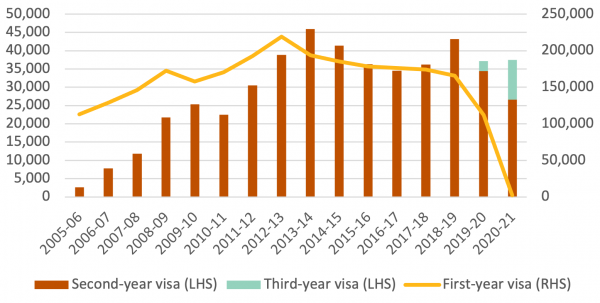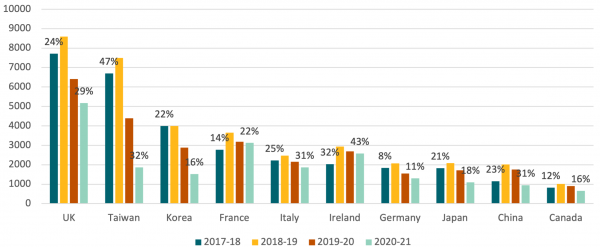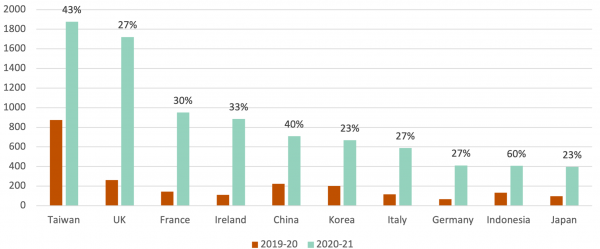When the third year backpacker visa extension was announced at the end of 2018, we speculated that one-third of second-year backpackers would take up the option of undertaking regional work – mainly working on a farm – for six months in their second year to be able to get a third-year visa.
July 2019 to June 2020 was the first period in which third year visas were handed out: 2,678 third-year visas were awarded that year, only 6% of the number of second-year visas the year before. Now data is available for last year, July 2020 to June 2021, or 2020-21, in which 10,873 visas were granted, 32% of second-year visas the year before.
That’s remarkably close to the 33% we predicted back in 2018. Perhaps a lucky coincidence, but it certainly suggests that the third-year visa is going to be a popular option, and that a significant number of backpackers readied themselves to take advantage of this new opportunity.
It took seven years for the second-year backpacker grant rate to reach 20% of the first-year grant rate, around which level it has since more or less stabilised. It remains to be seen whether the third-to-second-year ratio will stabilise at one-third or continue to rise.
Ratio of second-to-first and third-to-second backpacker visa grants
Also as predicted, the third-year visa is being used mainly as an agriculture visa: 73% of those granted a third-year visa in 2020-21 got one in return for farm work (this number based only on the first six months). Another 11% got it for construction work, and 8% for work in the accommodation and hospitality sector.
That 73% is, however, lower than the 79% who got their second-year visa in 2019-20 in return for farm work. And that 79% is below the historical average which was as high as 95% a few years ago.
There are two drivers of this shift away from farm work. One is a problem with data, with an increasing number of extensions granted for work “not classified” under the main (developed country) backpacker visa, the 417. The other is that visa extensions for the second backpacker visa, the 462 (mainly for developing countries), were only introduced in 2016, and from the start – unlike 417 visa holders – 462 holders could work in hospitality and tourism to get their extension (though only in northern Australia). 462 visa holders make up a growing share of backpackers, steadily rising from 1% in 2005-06 to 21% in 2020-21, and this has pushed down aggregate reliance on farm work.
The growing importance of the third-year visa is shown in the next graph. In 2020-21, there were virtually no new backpackers, and the growth in third-year backpackers fully offset the decline in second-year backpackers.
First, second and third year backpacker visa grants
Who are the second and third-year backpackers? The decline in second-year backpackers is concentrated in two countries that were seeing falls pre-COVID: Taiwan and South Korea. These countries’ backpackers are now less likely to extend, but the two are also now sending far fewer backpackers. In 2012-13, Korea sent the second highest number of new backpackers, and Taiwan the third highest. The UK retains its top position, but Korean and Taiwanese backpacker numbers had plummeted well before COVID, perhaps because of backpacker exploitation stories.
Top-ten countries for second-year backpacker extensions
Note: Labels show percentage who extend relative to those holding first-year visas the previous year. Top ten in 2018-19.
The importance of the UK explains why the long-running National Party push for an Asian agriculture visa was successful when the Australian government agreed to allow British backpackers to come to Australia for two years without any work requirement – just as Australian backpackers to the UK can.
The biggest countries for second-year extensions tend to be the biggest for the third, but Taiwan is in top place for the latter, and Indonesia makes it onto the list. 60% of Indonesians who extended for a second year did so for a third, and 40% or more of Chinese and Taiwanese.
Top-ten countries for third-year backpacker extension
Note: Labels show percentage who extend relative to those holding second-year visas the previous year. Top ten in 2020-21.
It will be interesting to see what happens to third-year numbers as international borders reopen. Given that most migrant numbers have fallen, one would guess that the third-year share would increase further. Yet another reason why we don’t need an Asian agriculture visa.
Note: All backpacker data is from the Department of Home Affairs. Extension ratios are calculated relative to the previous year’s base e.g. for 2019-20 third-to second, 2019-20 third-year visas over 2018-19 second-year visas.
Disclosure
This research was undertaken with support from the Pacific Research Program, funded by the Department of Foreign Affairs and Trade. The views are those of the authors only.


Leave a Comment